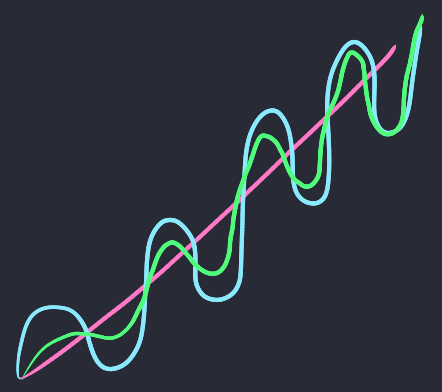All great questions, and I agree that “oops, we made a bezier” is a potential pitfall!
Off the cuff thoughts:
As to + vs *, probably switchable per stage (maybe even crossfadeable, if that proves interesting?) Some sort of bias control would also be useful for *, since literal multiplication by an unbiased bipolar signal is going to drop the envelope to zero every time there’s a zero-crossing. Half- or full-wave rectification could also come in handy. Since the multi-stage modulation (and smooth transitions thereof) is the quiddity of the plugin, I think lots of options to massage modulators and play well with various inputs is a good thing.
Outputs are so easy to code up and so useful that I think we shouldn’t stint on them. If we want to save HP we can always put EOS triggers, unmodulated outs, etc. on an output expander (pretty common place for them).
In terms of ADR time and S level, maybe along the lines of Fundamental VCA, knobs and CV only? The complexity here is the modulation, and a simpler envelope model might help bring that out.
I think the underlying ADSR should probably start simple, by which I guess I mean linear. My mind’s ear isn’t finding cases where modulation with exp or log would be fundamentally more interesting than modulation with lin (and arguably since exp or log spend more time near extrema than lin does, they’re closer to just applying the modulated signal by itself). Besides, a fancier version or tacked-on options can always come later.
I’ll add a question: I’m assuming we want this to be polyphonic in terms of input gates to output envelopes. If the modulators are monophonic, the ups and downs would be sync’d across all voices, so they would be wobbling in unison for a given stage (I’m imagining the simple case of an ADSR driving a VCA here).
Poly modulation inputs would be trivial to do, and we would of course apply a single-channel mod to all channels of the envelope if that’s all we got.
But getting really wild poly results with unsync’d modulators would require feeding a whole bunch of inputs in a useful configuration. We should assess whether existing poly LFOs are suitable for interesting results.
I can imagine trickery with delays (or a weird application of allpass filters, kind of like the “dome filter” in Bode shifters) to turn one LFO into a bunch for a poly context.
I can also imagine a companion LFO module designed to produce poly LFOs with useful characteristics for this ADSR!
This is turning into an open development thread, so anyone else with thoughts or requests should pile on…


